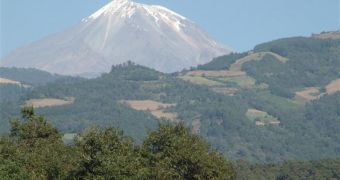If one looked for a place on Earth resembling the conditions on Mars, scientists found that Mexico's highest (dormant) volcano would fit. Now pine forests growing on slopes of the 13,780 feet (4,590 m) snow-capped Pico de Orizaba are investigated to see if trees could grow on a warmed Mars, as part of a vision of turning the chilly red planet into a human habitat in the future.
NASA is collaborating with Mexican universities to see if by warming up Mars by employing heat-trapping gases, increasing the air pressure and starting photosynthesis, they could create an atmosphere friendly to oxygen-requiring life forms, trees being a first important step. In Pico de Orizaba, which is also Mexico's tallest mountain, trees grow at higher altitude than anywhere else on the planet.
"It sounds like science fiction, but we think it's feasible," said Rafael Navarro-Gonzalez, professor at Mexico City's UNAM University, who's been studying for nine years Pico de Orizaba's pine forests.
"We have experienced warming our planet with greenhouse gases, but on Mars we could do it faster with more powerful gases," he said.
"The first human mission to Mars is seen 10 to 15 years away, and the warming-up process could start 50 years later," said NASA scientist Chris McKay.
Greenhouse effect gases like methane or nitrous oxide could rise Mars temperatures to 41? F (5? C) from - 67? F (-55? C) now;at these levels trees grow.
Trees, unlike simple plants (algae or lichens), would offer the possibility for humans to breathe air on Mars one day. The researchers are investigating now what impedes trees from growing above a certain altitude, where temperatures drop and the air becomes thinner.
"Things don't really start cooking from a biological point of view until trees start growing. Trees are the engines of the biosphere. It's possible Mars could have trees in 100 years. (But first) we need to understand what sets the tree line on Earth," said McKay.
Mars has a lifeless rocky surface, is hit by an intense burning ultra-violet radiation and has an extremely thin, carbon dioxide-filled atmosphere and still haunts human imagination looking for alien life. Many believe Mars has ice at its polar caps which could be melted and its subsoil harbors crucial elements required for life.
The Pico de Orizaba project plans to pump greenhouse effect gases into red planet's atmosphere, introduce photosynthetic bacteria and finally trees. The project would be stopped in case native Martian life is discovered.
"The idea is to explore the possibility of colonizing Mars. If there is life, we have no right to destroy it. But if Mars is barren we could take life from Earth to Mars," said Navarro-Gonzalez, thinking of turning the arid planet into a lush green world, with lakes and mineral-rich mountains that could in the future supply Earth.

 14 DAY TRIAL //
14 DAY TRIAL //